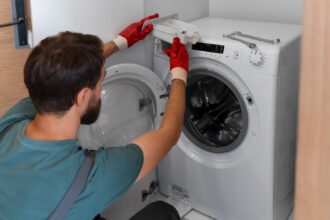When your appliances break down, it can be frustrating and costly. But what if you knew the secrets to fixing them quickly and efficiently? In this article, we’ll reveal insider tips from professional appliance repair technicians to help you diagnose and fix common issues.
Chapter 1: Preparation is Key
Before calling a technician, prepare yourself by gathering essential information. Take note of the appliance’s model number, serial number, and any error codes displayed. Additionally, have a clear understanding of the problem, including when it started and any symptoms.
Identifying Common Issues
Appliance repair technicians often encounter similar problems. For instance, faulty thermostats are common in refrigerators and ovens. Similarly, clogged filters can cause issues with dishwashers and washing machines. Knowing these common pitfalls can help you troubleshoot the problem more effectively.
Chapter 2: DIY Repair vs. Professional Help
While some repairs can be done DIY-style, others require professional expertise. For example, repairing a leaky faucet or replacing a light bulb are relatively simple tasks. However, tackling complex issues like electrical problems or refrigerant leaks should be left to the pros.
When to Call a Pro
If you’re unsure about your ability to fix an issue or if the problem persists after attempting repairs, it’s time to call in a professional. Additionally, if you notice signs of water damage, electrical hazards, or gas leaks, don’t hesitate to seek expert help immediately.
Chapter 3: Essential Tools and Equipment
Professional appliance repair technicians always carry essential tools and equipment. These may include multimeters for diagnosing electrical issues, refrigerant leak detectors, and specialized hand tools. Investing in a basic toolkit can help you tackle minor repairs and maintenance tasks.
The Importance of Safety
Safety should always be your top priority when working with appliances. Ensure you’ve turned off the power supply to the appliance before attempting any repairs. Additionally, wear protective gear like gloves and safety glasses to prevent injuries.
Chapter 4: Troubleshooting Techniques
Appliance repair technicians employ various troubleshooting techniques to identify issues quickly. For example, they may use the process of elimination to narrow down possible causes or utilize diagnostic charts to pinpoint problems. By adopting these strategies, you can more effectively diagnose and fix common appliance issues.
Using Online Resources
The internet is a valuable resource for DIY enthusiasts and professionals alike. Websites like iFixit and YouTube channels dedicated to appliance repair provide detailed tutorials and guides. Additionally, manufacturer websites often offer troubleshooting resources and documentation specific to your appliance model.
Chapter 5: Maintenance is Crucial
Regular maintenance can prevent many appliance issues from arising in the first place. Simple tasks like cleaning filters, checking electrical connections, and lubricating moving parts can go a long way in extending the lifespan of your appliances.
Scheduling Regular Maintenance
Create a schedule to ensure you stay on top of maintenance tasks. For example, clean your refrigerator’s condenser coils every 6 months or replace your washing machine’s hoses annually. By doing so, you’ll reduce the likelihood of unexpected breakdowns and costly repairs.
Chapter 6: Choosing the Right Replacement Parts
When replacing parts, it’s essential to choose components compatible with your appliance model. Consult your user manual or manufacturer website for guidance on selecting the correct replacement parts. Additionally, consider purchasing from authorized dealers or reputable online retailers to ensure authenticity and quality.
The Risks of Using Low-Quality Parts
Using low-quality or counterfeit parts can lead to further complications, including safety hazards and decreased performance. In some cases, these components may even void your appliance’s warranty. Always prioritize quality and authenticity when selecting replacement parts.
Chapter 7: Warranty and Maintenance Agreements
Many manufacturers offer extended warranties or maintenance agreements for their appliances. These contracts can provide peace of mind and protect your investment in the event of unexpected breakdowns. Weigh the costs and benefits of these agreements carefully before making a decision.
The Benefits of Preventive Maintenance
Preventive maintenance agreements often include routine inspections, cleaning, and minor repairs. By investing in these services, you can prevent issues from arising, reduce downtime, and extend the lifespan of your appliances.
Chapter 8: Conclusion
By mastering these appliance repair secrets revealed by the pros, you’ll be better equipped to diagnose and fix common issues efficiently. Remember to prioritize safety, invest in essential tools and equipment, and stay on top of maintenance tasks to prevent unexpected breakdowns. When in doubt, don’t hesitate to seek professional help from a licensed appliance repair technician.
Final Tips
- Always unplug appliances before attempting repairs.
- Keep your user manuals handy for quick reference.
- Consider enrolling in a preventive maintenance program for added protection and peace of mind.
By following these insider tips from the pros, you’ll be well on your way to becoming an appliance repair expert. Remember to stay safe, work efficiently, and prioritize quality when tackling repairs and maintenance tasks.
